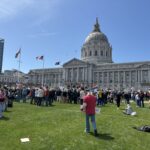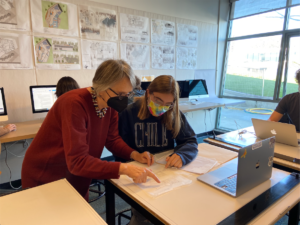The chance of nuclear war is higher than one may think — Stanford risk analysis expert Martin Hellman even goes as far as to say that a child born in 2009 has a 1 in 5 chance of experiencing a nuclear war. As a high school student growing up in a world with rising tensions between nuclear-armed states, that statistic is beyond terrifying. Nine countries have nuclear stockpiles, and there are almost 14,000 nuclear warheads in the world, each one capable of mass destruction. When I asked Hellman about the risk of nuclear war, he claimed without hesitation that “nuclear risk reduction is the most important thing for your generation to live to adulthood.”
I had the opportunity to attend the Urgent Appeal for a Nuclear Weapons Free World conference at the Peace Palace in the Hague in 2019, where scientists, politicians and activists came together to express concerns regarding nuclear war. Each speaker had a completely different set of lived experiences that tied them to the issue of nuclear weapons, and while this group was incredibly diverse, not a single speaker was under the age of 35 — most were significantly older. Why are younger generations so uninvolved in an issue that clearly affects us?
Hellman explained that people “think that the nuclear threat evaporated with the end of the Cold War, which is unfortunately not true.” Princeton nuclear researcher and professor Frank von Hippel explained the parallels between today’s U.S.-China relations and the Cold War, saying that “We’re playing with fire in terms of some of these nuclear technologies. It’s sort of a replay of the kinds of things that we were doing during the Cold War with the Soviet Union.”
However, as nuclear tensions shifted out of public consciousness following the fall of the Soviet Union, people became less concerned about nuclear weapons, and the nuclear disarmament movement lost momentum. My generation lacks the Cold War experience and, as a result, has trouble empathizing with advocacy against nuclear weapons. While the people currently advocating for nuclear disarmament and nonproliferation are doing phenomenal work, the movement will be unable to continue if it is not passed down to younger generations.
The rare robust youth disarmament movements exist in places where the effects of nuclear weapons are still felt today. Jessica Varnum of the Middlebury James Martin Center for Nonproliferation Studies said that “because of the history of the atomic bombings, there’s still a strong understanding (in Japan) of the importance of doing something about nuclear weapons. It’s, unfortunately, a lot less common in countries like the United States.”
In other words, the negative impacts of nuclear weapons are not tangible for American youth. As a result, the movement needs to find new and creative ways to make nuclear risk reduction accessible and relevant to younger generations. In the bold words of Frank von Hippel, “we need another uprising.”
A solution to the lack of youth involvement in nuclear risk reduction in the US is to tie it more directly to the environmental movement. A Pew Research Center survey from 2021 showed that a whopping 37% of Gen Z participants said that addressing climate change was their “top personal concern,” which is a higher percentage than any other age group that was surveyed. This profound fear and desire for meaningful action surrounding climate change has motivated my generation to engage with environmental issues, and Generation Z activists have moved to the forefront of the environmental movement.
However, the activism around the two issues is distinctly separate despite the fact that both movements could benefit immensely from associating themselves with one another. After all, any sort of nuclear conflict would devastate the environment. According to a study published by the American Association for the Advancement of Science, just a small-scale war between India and Pakistan would pump five million tons of carbon into the atmosphere, produce enough soot to reduce sunlight on the earth’s surface by up to 35% and cause a worldwide famine for at least a decade after the conflict.
To make matters worse, climate change greatly heightens the risk of nuclear war. Isabel Martinez, who is the program coordinator at the Council for a Livable World, said that “Climate change exacerbates already existing problems, our own Department of Defense views it as a ‘threat multiplier.’ A growing number of states could risk collapse as warming advances, and the use of — or acquisition of — nuclear weapons to attain and protect resources might start to look like a more viable option in the years ahead.”
The environmental movement cannot ignore the devastating impact nuclear weapons could have on the planet, and the nuclear risk reduction movement cannot ignore how climate change affects the risk of nuclear war — both movements need each other.
Nuclear weapons are indisputably an environmental issue, and there is so much potential for youth engagement in nuclear disarmament if the movement shifts its framework to appeal to my generation. Yes, I am terrified by the current risk of nuclear war and the lack of activism to address it. However, my generation’s fierce dedication to a habitable planet gives me hope. I am confident that with the proper education and outreach, this dedication can be channeled towards nuclear disarmament to protect our planet and our future.






